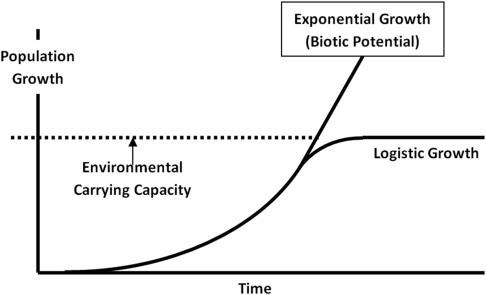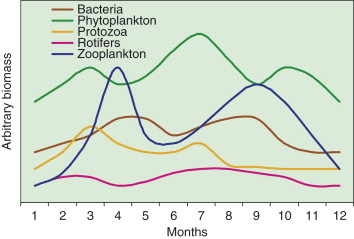
Biotic potential
n., plural: biotic potentials
[baɪˈɒt ɪk po(ʊ)ˈtɛnʃəl]
Definition: The potential of living organisms to produce their likes, as many as they could
Table of Contents
When we look at the different forms of life, we often wonder how they have continued to exist one generation after another. The different species of flora and fauna have devised various adaptive and behavioral techniques to make their populations stand against all the odds of extinction and forces of nature. On this line, we will like to introduce the topic of biotic potential to you. The biotic potential is the maximum number of individuals that a species can produce when it grows its population unabatedly. When the population’s growth (or the growth of the population of this species) is left uncontrolled and unrestricted (minimum biotic limiting factors), the “maximum growth rate” and “total population size” are reached. This highest value is the full biotic potential of that species. Since this is the display of the maximum reproductive potential of this species too, the biotic potential of a population is well understood as the direct derivative of the maximum reproductive ability of the members of the species. Read on more to learn about this topic in detail and with more examples to gain clarity on the intricacies of the subject.
Biotic Potential Definition
What is biotic potential?
When asked to define biotic potential, one can elaborate it as ‘unabated biotic potential growth of a population when the members of the population display their maximum reproductive capacities and produce the maximum progeny that they can’. In biology, the definition of biotic is anything pertaining to, related to, connected with, or in the effect of living organisms. These organisms are essentially made up of various organic materials or organic compounds, such as carbohydrates, proteins, lipids, and nucleic acids.
Biotic potential literally means the potential of living organisms to produce their likes, as many as they could. One can also comprehend the term as the proportional or total number or percentage hike in the total population of a given species.
In the subject of microbiology, one can relate the term biotic potential to the total increase in the “load” of the microbes in a patient’s body. The biotic potential of the infecting microorganism is manifested in the patient’s body when the force of infection is at its maximum due to the shortened doubling time and the highest possible microbial load in the infected individual. The maximal microbial load thus represents the biotic potential of such small organisms as microbial species.
Some important pointers that characterize biotic potential are:
- Highest birth rate
- Lowest mortality rate
- Maximal vital index
- Survival strategy of all life forms to ensure that their species is not discontinued, no matter what environmental potentials and factors play out.
- Since the maximum reproductive capacity is feasible only under optimal environmental conditions, hence biotic potential is expected to be expressed under optimum environmental conditions (favorable environmental conditions).
- The biotic potential is one of the two factors affecting carrying capacity; the other is environmental resistance. While environmental resistance limits the population, biotic potential drives population increase.
- This ‘biotic potential’ is a very basic and fundamental characteristic of any species.
The term was defined by Chapman in 1925. He defined biotic potential as the inherent power of living organisms to reproduce to make more of their kind and increase the chances and survivability of the species through evolutionary time scale.
Then in 1931, Chapman again took to the podium to redescribe biotic potential. He described it as a type of algebraic cumulative sum of the total number of young ones produced by the existing standing population at each reproductive event. He also added that the total number of reproduction events that take place over a duration of a given period of time and the existing sex ratio in any given species are also essential and determining factors for biotic potential. He also emphasized how the very basic and general ability of populations of a species to survive under varied physical conditions plays an essential role in the calculation of biotic potential. Now, in his description, Chapman related vital index to biotic potential. He formulated a vital index as the (number of births/number of deaths)x100. Adding to that, he said that biotic potential is the maximum value that’s possible for the vital index of any given species.

Watch this vid on the animal population’s biotic potential, particularly large mammals such as elephants
The biotic potential is the potential growth of a population of living things that can be expected if it were living under ideal environmental conditions and circumstances. It is, therefore, the point at which the birth rate is at its peak while the mortality rate is at its lowest.
Significance of Biotic Potential
By studying the increase and decrease in biotic potential over the time scale, one can be in a position to understand the varied and multi-dimensional impact of the environment and its micro-elemental factors on the populations of the species.
The role of environmental factors in decreasing the biotic potential can tell a lot about the mechanism of action of different factors. The sum of the environmental factors that limit population is called environmental resistance.
What 4 factors determine biotic potential?
- Typical reproductive age
- General frequency of reproductively available time/cycle
- How many offspring (or the total number of offspring) after birth that lives to their respective reproductive age
- Total number of offspring that are born at once (like litter size in dogs, usually high biotic potential)
- Total number of pregnancies in the entire lifetime
Quantitative Expression
The expression ‘biotic potential’ can be deciphered in both qualitative and quantitative manners. As we have looked at the definition in the previous section, let’s try to understand the quantitative full expression of the biotic potential. It is explained as the capability of a given species to withstand natural dynamic forces and challenges of any given environmental setup. It can be expressed in the form of a mathematical equation called ‘biotic potential equation’.
The equation expressing the biotic potential for a particular population is as follows:
(Number of representatives or individuals) x (Resistance of the Environment) = Biotic Potential
Resistance of the Environment can be because of various factors like biotic or abiotic factors. Some scientists have related biotic potential to an entity called “vital index” too. Regarding a ratio to find the rate of surviving members of a species, whereas:
Vital Index = (number of births/number of deaths)*100
Components
When asked what are the three biotic potentials, we can explain the reproductive potential, survival potential, nutritive potential, and protective potential. These account for both high and low biotic potential.
The necessary components of biotic potential can be further elaborated as:
- Reproductive potential: It is actually directly related to potential natality (birth rate). It defines the upper limit of biotic potential when only the maximal birth rate is counted and no mortality rate is taken into account.
- Survival potential: Since the reproductive potential is incapable to give accountability for the total number of gametes surviving in a population and hence the future biotic potential, hence survival potential gains prime importance. It emphasizes the role of available gametes in the future biotic potential of the species. It’s the reciprocal of mortality.
- Nutritive potential: It is the ability to gather and use food supply or resources for growth and energy.
- Protective potential: It is the ability of an organism to protect and guard itself against the destructive and challenging forces of the environment. This ability can ensure safe and secure successful mating and care for the young one.

Examples of Biotic Potential
The biotic potential is defined as the maximum reproductive success along with the maximum number of offspring resulting from each reproductive event. And so for example, in the dog and human populations, the biotic potential of dogs when compared to human beings, their litter size is comparably much larger than human beings’ babies. Comparing other large mammals such as humans and elephants, they produce very few, such as only one offspring per year. Insects, on the contrary, are small animals that have relatively high biotic potential. They can produce thousands of offspring per year. This shows that humans have lower biotic potential relative to most organisms and in almost all the animals. Nevertheless, the human population continues to grow continuously over the years.
As for plants, some plant species produce more seeds and result in more offspring when the seeds germinate.
Answer the quiz below to check what you have learned so far about biotic potential.
References
- Moore, Gary. Living with the Earth, Third Edition: Concepts in Environmental Health Science.
- D’Ancona, Umberto (1954). The Struggle for Existence. Leiden, Brill.
- Nebel, Bernard; Wright, Richard. Environmental Science: The Way the World Works.
- Henry R. Hermann Ph.D., Dominance and Aggression in Humans and Other Animals, 2017
- K.S. Christoffersen, in Encyclopedia of Ecology, 2008
©BiologyOnline.com. Content provided and moderated by Biology Online Editors.


